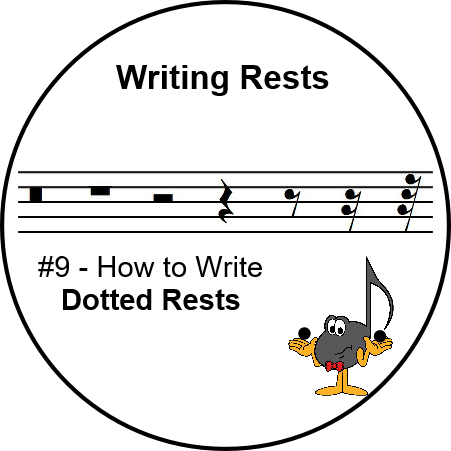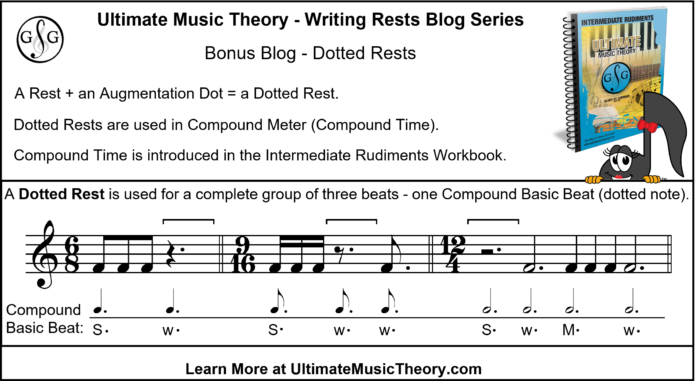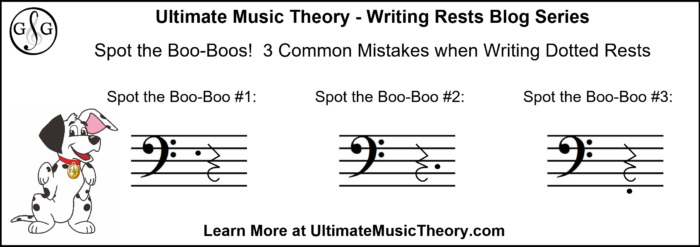Writing Rests #9 – Dotted Rests

Welcome to the Ultimate Music Theory Blog Series on How to Write Rests.
- Writing Rests Blog Series #1 - How to Write a Breve Rest
- Writing Rests Blog Series #2 - How to Write a Whole Rest
- Writing Rests Blog Series #3 - How to Write a Half Rest
- Writing Rests Blog Series #4 - How to Write a Quarter Rest
- Writing Rests Blog Series #5 - How to Write an Eighth Rest
- Writing Rests Blog Series #6 - How to Write a Sixteenth Rest
- Writing Rests Blog Series #7 - How to Write a Thirty-Second Rest
- Writing Rests Blog Series #8 - How to Write a Sixty-Fourth Rest
In this BONUS ninth blog in this Writing Rests Blog Series, we explore How to Write Dotted Rests.
Rests Have Rules! This Series explores how to write the rests properly by hand. It is not about when we write particular rests. If you have any concern, either as a Student or as a Teacher, about what rests should be used, Ultimate Music Theory has lots of ways to help:
- Teach Rhythm and Rests - This online course is perfect for giving you confidence as a Teacher. You will discover how to easily determine the division of rhythm & rests.
- Complete Music Theory Course - This online course is a great "refresher" course for Teachers and is perfect for Senior Students who wish to prepare for entrance to any Post-Secondary School for Music.
- Ultimate Music Theory Certification Course - Want to take your Teaching to the next level of Excellence? This online course will do that. Join the hundreds of UMTC Certified Teachers around the world who have expanded their Studios and their Teaching Confidence.
The Dolmetsch Online Music Dictionary says that a Dotted Rest is a rest followed by a dot. This Dot is called an "Augmentation Dot" or a "Dot of Prolongation".

Writing Rests Blog #9 - Dotted Rests
A single dot extends a note or rest by half of its (undotted) duration. A second dot extends a note or rest by a further quarter of its (undotted) duration.
This "Augmentation dot" is also called:
- a punto (de valore) (in Italian)
- a point (in French)
- a Punkt (in German)
- a puntillo (in Spanish)

How to Write Dotted Rests by Hand
A dot is a black (darkened, filled in) circle written in the center of the Space. According to the Norton Manual of Music Notation, here are 3 Rules for Writing Dotted Rests:
Rule #1: A Breve Rest is not written with a dot. When I write my Blogs, I confirm my information with reputable Music Theory Books, Websites and by looking through my own extensive music library for examples. I simply could not find any instances of a Dotted Breve Rest. While I understand that it is "possible", I can't find any in print. So, let's just say that we probably will never use a Dotted Breve Rest. (Please let me know if you find an example!)
Rule #2: For a Whole Rest, Half Rest, Quarter Rest, Eighth Rest and Sixteenth Rest, the dot is written after the rest (to the right) in Space #3. No matter what Staff you are in, these rests will become dotted by adding the dot after the rest in Space #3.
Rule #3: For a Thirty-Second Rest and a Sixty-Fourth Rest, the dot is written after the rest (to the right) in Space #4.
Just a reminder that this Series is based upon music that is not written with separate "voicing" (for example, Stems Up in the Treble Staff for the Soprano Voice and Stems Down for the Alto Voice).
As the Examiner for the Ultimate Music Theory Certification Course, I see so many sloppy rests. Please practice how to draw these rests! If you cannot draw them properly, you will struggle to teach your Students how to draw them properly.
We should not be sloppy Teachers! Using your Ultimate Music Theory Whiteboard is a great way to practice writing (drawing) rests correctly.

Dotted Rests - Spot the Boo-Boos
Spot (the Dog) likes to play "Spot the Boo-Boos". Can you spot the error for each of the above Dotted Rest Examples?
Here are the answers:
- Spot the Boo-Boo #1: The Dot is written after the rest, and not before the rest.
- Spot the Boo-Boo #2: For a Dotted Quarter Rest, the dot must be written in Space #3.
- Spot the Boo-Boo #3: A Dotted Rest always has the dot written to the right of the rest. It is never written below the rest. (There is no such thing as a "Staccato Rest".)
Did you Spot all the Boo-Boos?
The Writing Rests Blog Series
This Blog Series has focused on how to write rests, and not on WHAT rest to write. Each Blog also has a matching Worksheet (with a corresponding Answer Sheet). To get these resources, join the Ultimate Music Theory Membership!
Thank you for reading!
And, if you missed any of the Blogs in the Writing Rests Series, please check them out:
- Writing Rests Blog #1 - Breve Rest
- Writing Rests Blog #2 - Whole Rest
- Writing Rests Blog #3 - Half Rest
- Writing Rests Blog #4 - Quarter Rest
- Writing Rests Blog #5 - Eighth Rest
- Writing Rests Blog #6 - Sixteenth Rest
- Writing Rests Blog #7 - Thirty-Second Rest
- Writing Rests Blog #8 - Bonus Blog - Sixty-Fourth Rest
Ultimate Music Teachers Membership
♪ LEARN ♪ PLAN ♪ TEACH ♪ GROW
The One & ONLY Ultimate Music Teachers Membership
To Become A UMT PRO!
Your Success Path Starts Here - Go To TeachUMT.com Today!
Keep on Learning... With a Smile and a Song!
Shelagh McKibbon-U'Ren



Interesting that the dots for the 32nd & 64th rests are in Space 4 rather than space 3—I would have thought the location would always be Space 3 precisely for consistency visually…
I know, right! I actually questioned this and confirmed it just to make certain! So, the way that I teach it to my students is that Dots ALWAYS go in “Party Space #3” for rests. For the 32nd and 64th rest, we just write the first dot IN “Party Space #3”, and then the second dot above it! Shelagh